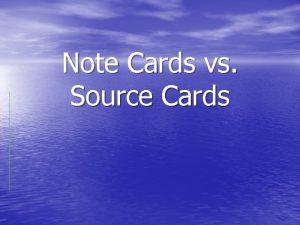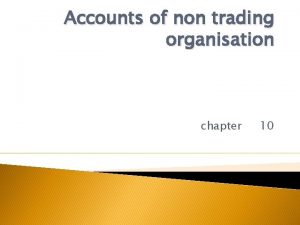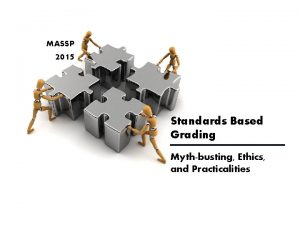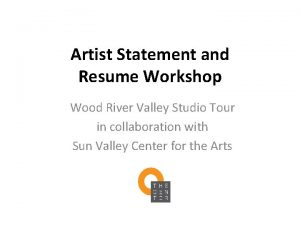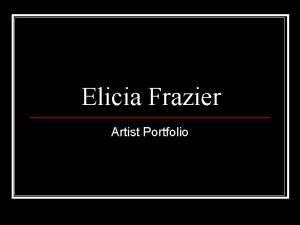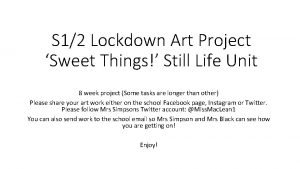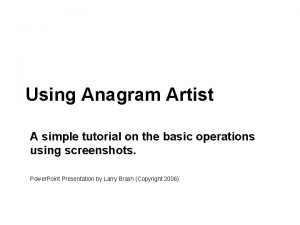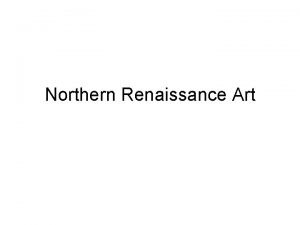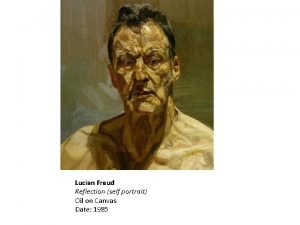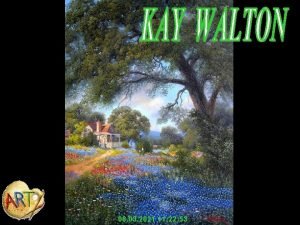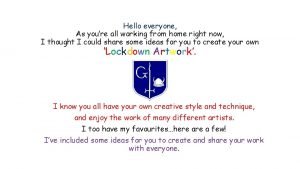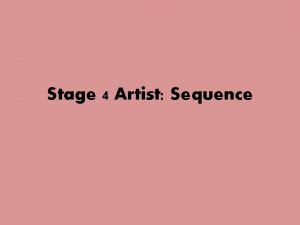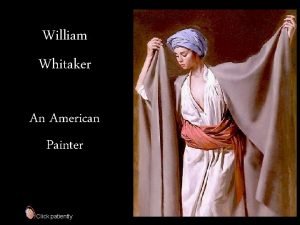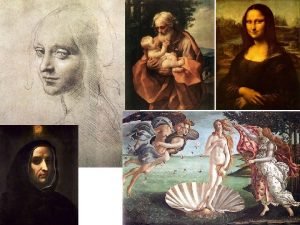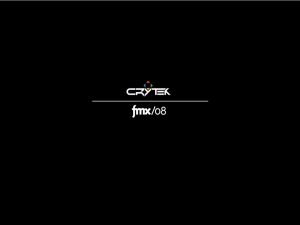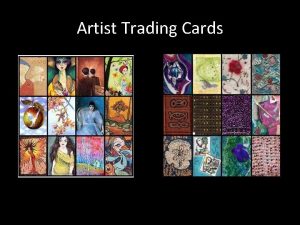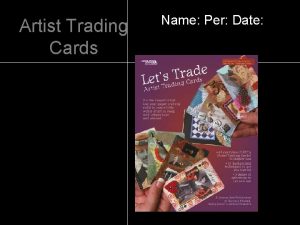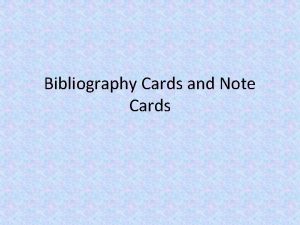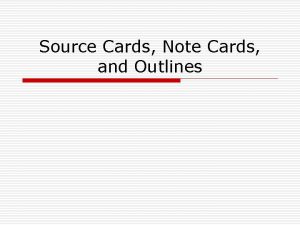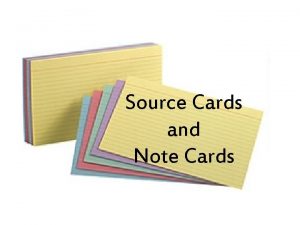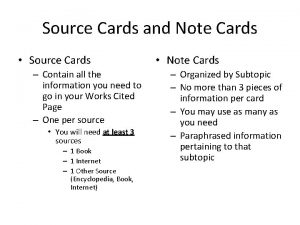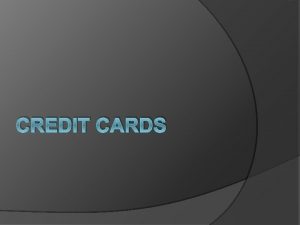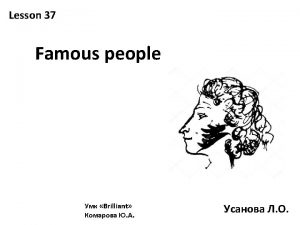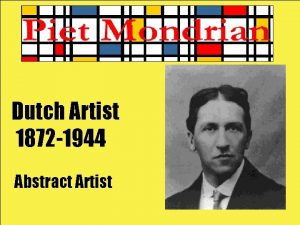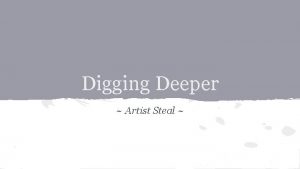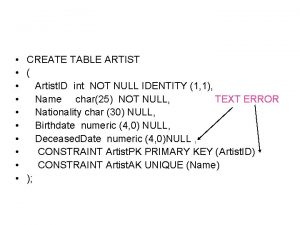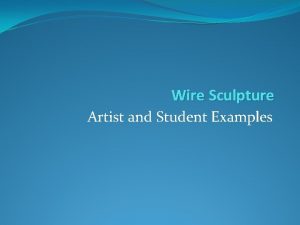ARTIST TRADING CARDS ATCs Artist Trading Cards ATCs



































- Slides: 35

ARTIST TRADING CARDS

ATC’s Artist Trading Cards (ATC’s) are miniature pieces of art that are traded around the world. Artists create, trade and collect art at organized “swap” events, either in person or online. It is a great way to meet other artists and share your work. The only official rule for ATC’s is the size: 2. 5” x 3. 5”. Details including artist name, name of the ATC, contact information, and numbering, are written on the backside.


Artist Trading Card (ATC) Trivia ATC’s are miniature works of art The idea of making ATC’s was born in 1997 by Swiss artist M. Vanci Stirnemann. He wanted to document his work, and the work of others at the conference, and discovered that the cost was far too grand to print a catalogue of the 1, 200 participants. Stirnemann decided to create 1, 200 cards by hand so that he could distribute them to everyone who attended the art show. Everyone was encouraged to do the same, and at the end of the show, the ATC’s were traded. This was a very successful idea that rapidly spread across the world.

ATC Swaps Today there are ATC swaps in almost every major city around the world. There also many online swaps. Most swaps are open to any media, materials or techniques as long as the card fits into a standard trading card sleeve. Art can be original, limited edition or series. ATC’s are never sold–only traded ATC’s are the size of a baseball card– 2 ½” x 3 ½”


By definition ATCs are made in limited numbers, often no more than one of a kind. Unique ATCs are called originals; and are numbered; Sets of ATCs that are based on one theme but that are different are called series “Painted Desert” by Roger L. Waggener "Toothill Ranges Dry River Bed and Tracks” by Llewena Newell

ATC’s and ACEO’s Art can be original, limited edition or series. Artists should include part or all of the following informati 0 n on the back of the card: Name Contact Information Title of piece Number if it is part of an edition or series (1/8, 2/8. . . )

How to Trade Cards You can locate an in-person swap in your area, find an online swap, or organize your own swap. There a number of Web sites that others have created to help artists get started. They can be found by doing online searches using key words such as “ artist trading cards. ” Source: http: //www. altered-art. net/

Artist Trading Cards have been around for less than a decade. Yet, their historical roots can be traced back to the Mail Art movement of the 1960 s, and even earlier to the Dadaist movement of the 1920 s. Swiss artist M. Vanci Stirnemann first developed the concept of Artist Trading Cards in 1996, when he decided to document his activities with other artists by producing a catalogue of 1, 200 cards he created by hand. He exhibited the cards at his bookstore gallery in Zürich in May 1997. On the last day of the exhibit, Stirnemann invited anyone who wanted a card to create their own ATC to trade during the closing reception.

Lorna Lovell

Gillian Allen

Cinda Oliverio

Lilla Le Vine

Becky Christian




How to Make ATC’s and ACEO’s The list of possible subjects is endless, and amongst the techniques which can be used are painting, collage, rubber stamping, needlework, beading, photography, digital image manipulation… You'll need a piece of suitable material, 2½ by 3½ inches in size. It may be in either portrait or landscape orientation, and the corners can be either rounded or unrounded; it's purely a matter of personal preference. It's usual to use cardstock, but other possibilities include fabric, canvas, leather, acetate, metal and cork sheet. You could even use playing cards, if they are the right size.

Backgrounds Whatever you use has to be fairly flat; although artist trading cards may include three-dimensional elements like buttons and charms, most swap groups insist that they are thin enough to fit in a standard trading card sleeve. It also needs to have a certain stiffness, so you might have to back fabric or canvas, for example, with card or interfacing.

Another great way to create backgrounds is with rubber stamps. Combine stamped images with other techniques by, for example, using a repeated motif or a stamp specially designed for the purpose. These include collaged images and textures, like crackled paintwork or various fabrics. You can also apply ink from a stamp pad using a rubber roller, or brayer, to produce different effects, or use your ink pad to apply color directly to your surface with a dabbing or rubbing motion.

Another readily available source for backgrounds is the wealth of designer papers intended for scrapbooking. These can be found in a wide variety of colors and designs to suit every subject. Look for interesting textures and effects like old wood and distressed paintwork, or old manuscripts, books, music and maps. Alternatively, if you find old magazines, newspapers and books that nobody wants, why not use the real thing? You can cover the whole card with one piece, or with several different pieces torn into strips or mosaic shapes.

Backgrounds –not plain

Textural elements added

You may also find pictures in magazines and travel brochures which would make ideal backgrounds for your theme. The important thing is that the image should complement, and not compete with, your main subject. Many of those who make artist trading cards prefer to create their own backgrounds using paint, color washes, chalks or inks.

Adding a Focal Point

Add Embellishments

The Addition of Text

Techniques for Altered Art Collage Designer Papers Die Cutting Embellishments Fabrics and Other Materials Acetate Canvas Chipboard Fabrics and Lace Fibers Friendly Plastic®Metal Foil Flakes Paper Clay Polymer Clay Shrink Plastic Ultra-thick Embossing Enamel (UTEE)

Glues and Adhesives Paints, Inks and Glazes Paints Inks Glazes Rubber Stamping o Rubber Stamps Rubber Stamping Inks Rubber Stamping Techniques Brayer Techniques Direct-to-Paper Techniques Embossing Techniques Resist Techniques Tools





 Source cards
Source cards Civil war trading cards project
Civil war trading cards project Big huge lab
Big huge lab What do you mean by non trading organisation
What do you mean by non trading organisation Climb that tree cartoon artist
Climb that tree cartoon artist Nirsp login
Nirsp login Artist statement sample
Artist statement sample Portrait artist portfolio
Portrait artist portfolio What is your favorite singer?
What is your favorite singer? Storyboard artist bertugas untuk
Storyboard artist bertugas untuk Portrait of josette gris
Portrait of josette gris Gop colour
Gop colour Name the artist
Name the artist Kodglidning
Kodglidning Shirin neshat ted talk
Shirin neshat ted talk Joel penkman artist research
Joel penkman artist research Andy nature artist
Andy nature artist Who makes sculptures
Who makes sculptures Blu graffiti
Blu graffiti Anagram of artist
Anagram of artist Italian renaissance vs northern renaissance art
Italian renaissance vs northern renaissance art Andrew whittle artist
Andrew whittle artist Title
Title Lucian freud reflection analysis
Lucian freud reflection analysis Digital imaging artist
Digital imaging artist Alex walton berkeley
Alex walton berkeley Jill douglas interview
Jill douglas interview Barkwash
Barkwash British artist
British artist Artist sequence
Artist sequence Vince low artist research page
Vince low artist research page William whitaker artist
William whitaker artist Name of artist
Name of artist Christopher evans artist
Christopher evans artist Heather hansen artist
Heather hansen artist Kingdom artist
Kingdom artist
